1966 Belgian Grand Prix race report: Surtees slides to victory
John Surtees survives the carnage of a wet Spa to win for Ferrari; Cooper's Jochen Rindt finishes an impressive second
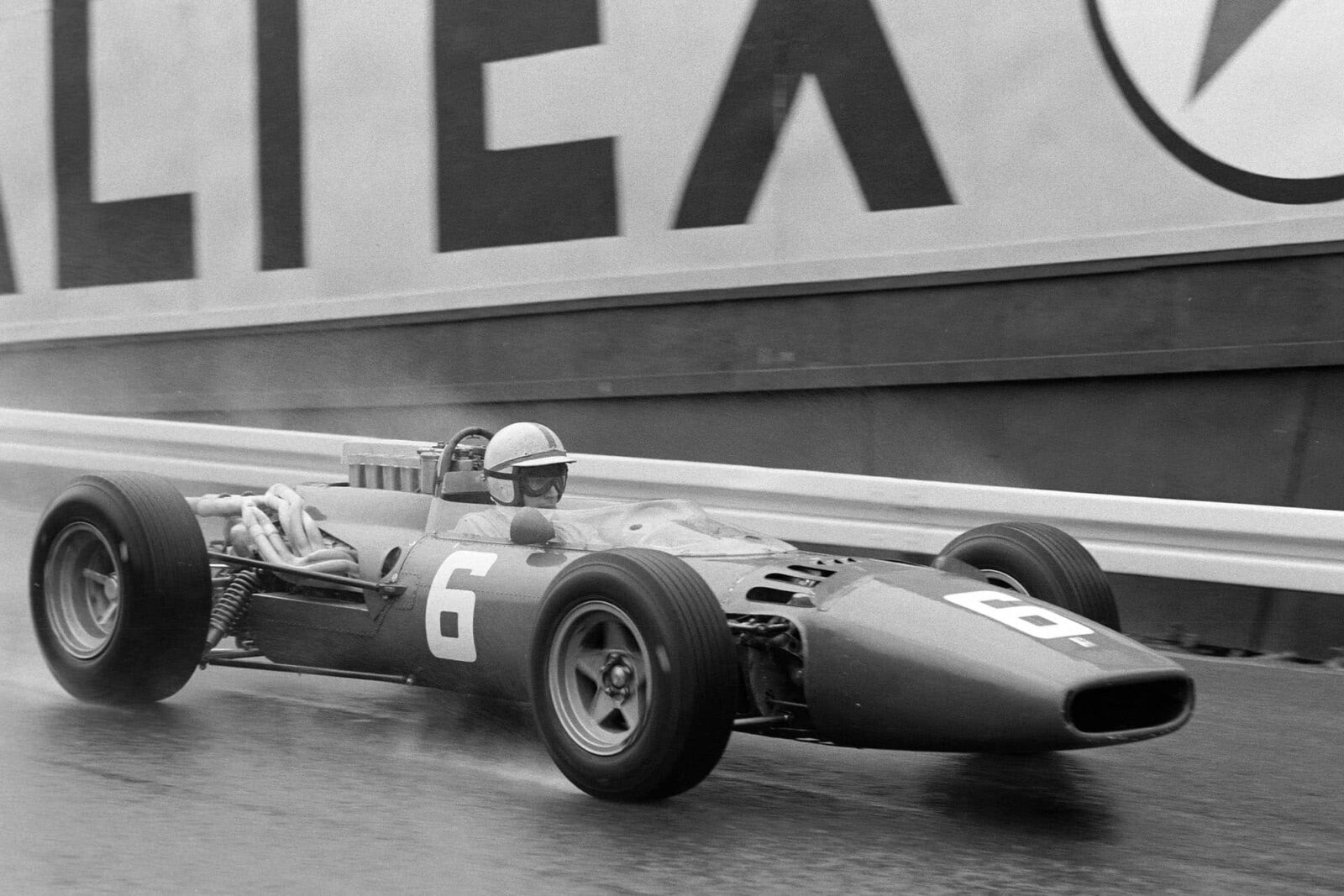
Surtees survived a race of attrition, winning from pole
Motorsport Images
The second race in the 1966 series of Grandes Epreuves was the Belgian event, held on the traditional and splendid “Circuit Permanent of Francorchamps” in the hills above the town of Spa. This real Grand Prix circuit formed from the normal road system, but with permanent pits, paddock and grandstands, was obviously going to allow the new 3-litre Grand Prix cars to show their true worth. New 3-litre machinery dominated the pit area in practice, though much of it was unraced and some was even untried, but nevertheless the quantity and variety showed healthy progress for the new Grand Prix Formula, which is still in very early days.
Jack Brabham had his V8 Repco-engined car, as at Monaco, Ferrari had the two V12-engined cars already seen, all five Cooper-Maserati V12 cars were present, comprising the two works cars and the three privately-owned ones, BRM had two H16-cylinder cars, Team Lotus had their first new car with H16-cylinder BRM engine, McLaren had his Monaco car, but had fitted a V8 Serenissima engine in place of the Indianapolis-type Ford V8, which is undergoing some redesigning, and Gurney had the first of his All-American Racers Eagle cars, temporarily fitted with a 2.7-litre Coventry-Climax 4-cylinder engine until his V12 Weslake engine is ready.
To make up the numbers, or to be used if the new 3-litre cars proved un-raceworthy, were the stop-gap cars, Hulme’s 4-cylinder 2.5-litre. Coventry-Climax powered works Brabham, the Dino 2.4-litre V6 Ferrari for Bandini, the Team Lotus car R11, with 2-litre Coventry-Climax V8 engine, two works BRM 2-litre V8 Tasman cars, Parnell’s Lotus-BRM 2-litre V8 for Spence, and Team Chamaco-Collect’s ex-works BRM 2-litre V8 for Bondurant.
There were those optimists among the unknowledgeable who expected miracles from new engines or new chassis, and who seemed surprised and upset when teams or drivers showed more interest in the obsolete smaller-engined cars. It is one thing to design a new car or a new engine, quite an achievement to actually build the design and make it run, but then the real work begins, which is to make it race worthy, let alone a winner.
Qualifying
Practice began on Friday afternoon and Stewart was soon setting the pace with a 2-litre V8 BRM, but the Ferrari team seemed very happy and confident, and it was clearly only a matter of time before Surtees began to extend the 3-litre V12 Ferrari. Although the Grand Prix lap record stood to Gurney in a 1 1/2-litre Brabham-Climax V8 with 3min 49.2sec, set up in 1964.
Last year Graham Hill had lapped in practice at 3min 45.4sec in a 1 1/2-litre BRM V8. Earlier this year Parkes had set a new course record with a prototype sports Car 330P/3 Ferrari with 3min 46.4sec, and there were those who seemed to think the 3-litre GP cars would not beat this figure! As the 2-litre BRMs were last year’s cars with an extra 500cc and subsequent horsepower increase, an improvement on 3min 45sec would present no difficulty and 3min 40sec did not seem an optimistic target for the 3-litre Ferrari in this first practice period.

McLaren entered his own eponymous team and car.
Motorsport Images
Weather conditions were splendid as Stewart kept knocking seconds off his lap times, being down among the 3min 43sec to 3min 42sec bracket quite early on. Bandini was practising with the 2.4-litre V6 and going very fast, while Brabham was quietly getting on with the job and was well in the running. Others were in dire trouble, Ginther’s Cooper-Maserati V12 broke its self-locking differential while he was getting ready to practise, Rindt had barely begun to learn his way round before his engine broke, and Clark only did one lap in his Lotus to discover that the wrong final drive ratio had been fitted.
Arundell did three exploratory laps with the brand new Lotus, with 3-litre H16-cylinder BRM engine, before it suffered an internal breakage, and McLaren was having oil-leaking problems amongst others, with his temporary Serenissima V8 engine. Gurney was running his Eagle with a 4-cylinder Coventry-Climax engine and Hewland gearbox in order to get experience with the new chassis, until the proper engine is ready, but he was having minor troubles with the mechanical components. Both BRM works drivers had a new 16-cylinder car at their disposal and did some tentative laps, but seemed to be concentrating on the V8 engined cars.
The timekeepers were given no indication of which car a driver was using, so that they did not know which car did the fast times, but both Hill and Stewart made their fast laps with the 2-litre V8 cars. Surtees tried the V12 Ferrari on Firestone tyres as well as Dunlop, his car being the one he used at Monaco, and was fitted with knock-off rear hubs and wheels as used on the P3 sports prototype. Bandini’s V12 Ferrari, which he did not use until the second practice, had this type of hub and wheel both back and front.
The V12 Ferrari trouble at Monaco had proved to be a broken differential housing, caused by the fact that the twisty circuit and extra power of the 3-litre engine was demanding that the differential was working overtime, the car seldom running absolutely dead straight. Nothing seemed to be going right for Clark, or Team Lotus, as their new car could not be repaired and the 2-litre was giving trouble with its gear-change, the engine was not going well and it finally broke, and grease ran out of the front hubs all over the brakes. Through all this Clark was getting more and more disgusted and making very little progress.
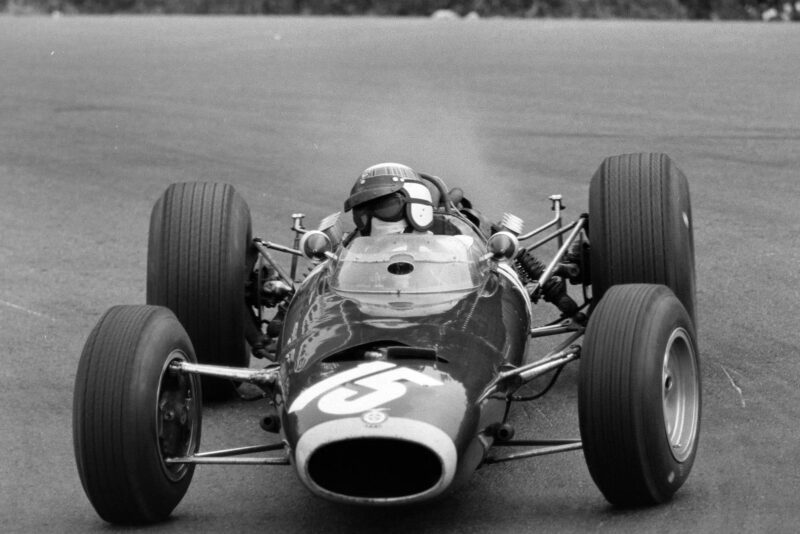
Stewart set the early pace in qualifying
Motorsport Images
Coopers were not much happier for though they had made redesigned drive-shafts to obviate their Monaco troubles, and had fitted the three private owner cars as well as their own with them, other troubles had arisen. Once the V12 Ferrari had been adjusted right, Surtees began to use its potential and he was very soon going faster than Stewart, and without too much effort he recorded 3min 40.4sec, to set FTD for the afternoon, an average of just over 143mph, and there was more to come.
During the two-hour session, which was barely long enough, Phil Hill had been circulating in MGM’s McLaren-Ford V8 single-seater with a camera on the front, taking films of people practising. Before the Saturday practice began the Grand Prix Drivers’ Association foregathered and decided that this business of a camera-car circulating amongst them, while they were practising for a serious event, was getting a bit out of hand and in future should be restricted to a special period at the end of official practice.
The Saturday practice was delayed for 45 minutes while the local fire-brigade dealt with a forest fire up in the Burnenville hills, but it had not been started by the film-making crowd as some unkind people suggested. Surtees was all set to go, mounted on Firestone tyres, and the moment the circuit was clear he was off and in no time at all had clocked a shattering 3min 38.0sec, nearly 145mph average, and at that seemed content to sit back and see if anyone could match his performance.
“The Saturday practice was delayed for 45 minutes while the local fire-brigade dealt with a forest fire up in the Burnenville hills, but it had not been started by the film-making crowd as some unkind people suggested”
Needless to say no-one could, for the new BRMs were far from right and Stewart and Hill were concentrating on the old 2-litres while Team Lotus had no cars at all, Chapman and Clark having flown to England to rustle up some parts for the V8, the new H16 BRM-engined car being beyond immediate repair. Hulme was just leaving the pits when a front-wheel bearing seized solid, but Brabham was getting on all right. Coopers seemed to be overcoming their troubles and Rindt did a praiseworthy 3min 41.2sec to take second FTD from Stewart, but Surtees was unapproachable.
Neither Gurney nor McLaren seemed to be making any headway at all, both suffering at times from a surplus of oil in the wrong places, and they could not even approach a good 1 1/2-litre lap time. McLaren’s sports-type Serenissima engine finally broke up its bearings, which put paid to his hopes of starting the race as he had no spare engine. Bonnier’s Cooper-Maserati V12 was going well and Spence made a very good time with Parnell’s Lotus-BRM 2-litre.
Due to the delayed start practice was extended from 6pm to 6:30pm, but Surtees’ opening laps remained unbeaten. For both days of practice the weather had been superb, but on Sunday morning the sky was cloudy and overcast and rain was in the offing. Team Lotus had repaired Clark’s car and during the morning he went out to try it, but had not gone far when a rear suspension part collapsed and he skated to rest on the chassis.
There was a panic as the car was rushed back to the garage for repairs and inspection, with the result that they were very late in arriving at the pits after lunch, for the 3:30pm start. Both works BRM drivers had been delegated to the 2-litre V8-engined ears, Bandini had decided to stick to the V6 Ferrari until he had become more accustomed to the more powerful V12 Ferrari, and he and Surtees had their cars mounted on Firestone dry-road tyres.
Siffert’s Maserati engine was showing signs of an internal water leak, and Bondurant’s BRM had been painted to look like the works McLaren and was carrying McLaren’s number for the benefit of the film people, to whom accuracy would appear to be of secondary importance. As starting time drew near rain was imminent, so Ferraris changed back to Dunlop wet-road tyres rather than take a risk with Firestone wet-weather tyres that they had not tried.
Race
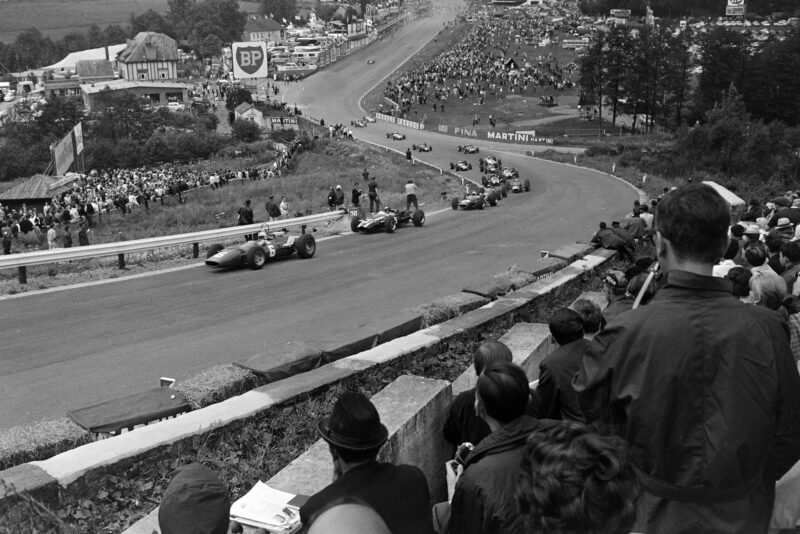
Surtees heads the field up into Eau Rouge
Motorsport Images
After the drivers had been taken round the circuit on a parade lap in the passenger seats of various open cars, and the film people had used up time on “mock racing,” the cars were assembled on the grid and with two minutes to go all fifteen engines were running and making a fine sound. As they moved down to the start line An anxious Jochen Rindt was in the centre of the front row, with Surtees on his left and Stewart on his right, and rain-clouds could be seen over the hills ahead of them.
It was indeed strange to see Clark and Graham Hill side by side on the fourth row of the grid as the flag fell, some seconds prematurely, Clark was not ready and got left behind. The leaders were over the Eau Rouge, with Surtees already in front, as Clark gave his Lotus-Climax a great bootfull of revs and stormed off in pursuit. The cars were still within earshot when the loudspeakers, announced that the rain previously reported at Stavelot had now reached Malmedy, and the order was Surtees (Ferrari), Rindt (Cooper-Maserati), Brabham (Brabham-Repco), Bandini (Ferrari) and Stewart (BRM), and then there was an announcement that Bonnier and Spence had gone off the road at Burnenville but were unhurt.
“There were nine cars missing on this opening lap”
Surtees was announced as still leading at Stavelot, but this was followed by a garbled message that Stewart and Hill had gone off the road on the Masta straight, but that Hill was going to continue. The leaders could be heard approaching from Blanchimont and soon Surtees shot into view on the approach to La Source hairpin. He rounded the corner and was down past the pits before Brabham appeared with Bandini right behind him. Then came Ginther, Rindt and Ligier and a complete silence with no more cars appearing; there were nine cars missing on this opening lap.
A long while later Gurney appeared, not going very fast, and then Phil Hill drew into the pits with the camera-car. The leaders were now due to re-appear and this time it was Bandini who led, followed by Surtees, Rindt and Brabham, with Ginther and Ligier already some way hack, and the rain which had obviously precipitated the first-lap incidents now reached the pit area.
On lap three Surtees was back in the lead. with Rindt and Bandini in his wake, Brabham quite a long way back and Ginther and Ligier even further back, the only remaining runner being Gurney, going very slowly with a sick engine. Hulme then appeared with his right front suspension bent back and the wheel travelling sideways, and retired at the pits. On the next lap Rindt had forced his Cooper-Maserati through the spray of the leading Ferrari and was now commanding the race, Surtees prudently dropping back just out of range of the spray from the Cooper’s wheels, while Bandini dropped much further back.
While the runners were on their fifth lap Graham Hill came round in his BRM and stopped at the pits, while an ambulance brought Stewart and Bondurant into the paddock hospital for attention. Gradually the holocaust of the opening lap was pieced together, for Clark had arrived back on foot, his engine having broken before he reached the top of the Burnenville hill.
Down the other side Bonnier and Spence had lost control on the wet road, as had Siffert and Hulme, and at the ess-bend in the very fast Masta straight Rindt had experienced monumental series of spins on the wet track but was able to continue, while Stewart, Bondurant and Hill had also spun, in that order, the first two crashing and Hill coming to rest unscathed in the straw bales. He and Bondurant had extracted the injured Stewart from his wrecked BRM.
With rain all round the circuit the race speed was relatively low. Rindt lapping in around 4min 30sec, but he was doing a most courageous job of work at an average speed of nearly 105mph. Surtees was content to let the Cooper driver set the pace and stayed just clear of the flying spray and by the eighth lap they had lapped Ginther, as had Bandini who was holding a lonely third position.
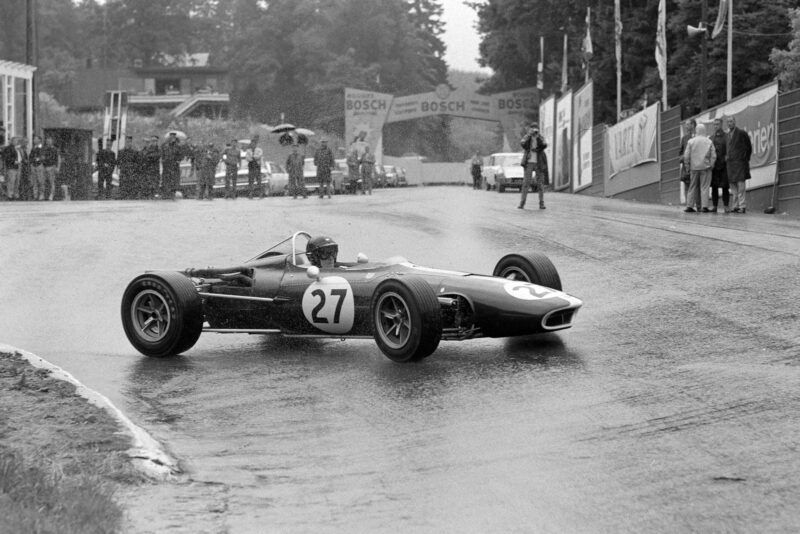
Gurney struggled for pace in his AAR Eagle
Motorsport Images
Ligier stopped at the pits to adjust his clutch and lower his tyre pressures, and there were only seven cars circulating, Gurney being a long way last and going slow enough at times to hear the race order on the loudspeaker system! The rain kept on and on and there was no question of any overtaking, it was a matter of keeping going and not sliding off the road. Brabham was fourth and each time past the pits he seemed surprised to find his pit crew were still there and were signalling him how the race was progressing.
“Gurney being a long way last and going slow enough at times to hear the race order on the loudspeaker system”
In past years the Belgian GP had been over 36 laps, last year it was 32 laps, and this year it had been shortened still further to 28 laps, for which everyone was grateful under the prevailing conditions. By 20 laps the rain was easing and Surtees could see the Cooper-Maserati in front of him, instead of merely a cloud of spray. Rindt’s car was having trouble with the limited-slip differential, which did not affect the car too badly on the streaming wet roads but as the surface dried he was troubled more and more, and when Surtees went by into the lead on lap 21, as expected, Rindt could not do much about it.
They both lapped Bandini before the end and Surtees won a gruelling and unhappy Belgian Grand Prix, with a very courageous Jochen Rindt a few seconds behind in second place, much to the joy of the Cooper team. The young Austrian driver had begun to show the possibilities of the Cooper-Maserati in practice, and had done a splendid job of work in the very difficult race conditions, and it was no disgrace to be beaten by John Surtees and the V12 Ferrari.
If the rain had not stopped and the track dried out it would have been interesting to have seen the outcome, but no-one would have wished the seven survivors to drive in the rain longer than was necessary. The new FIA rules state that competitors must complete 90% of the total race distance in order to be classified as a finisher, and poor Ligier missed out by less than a lap, after persevering so hard.
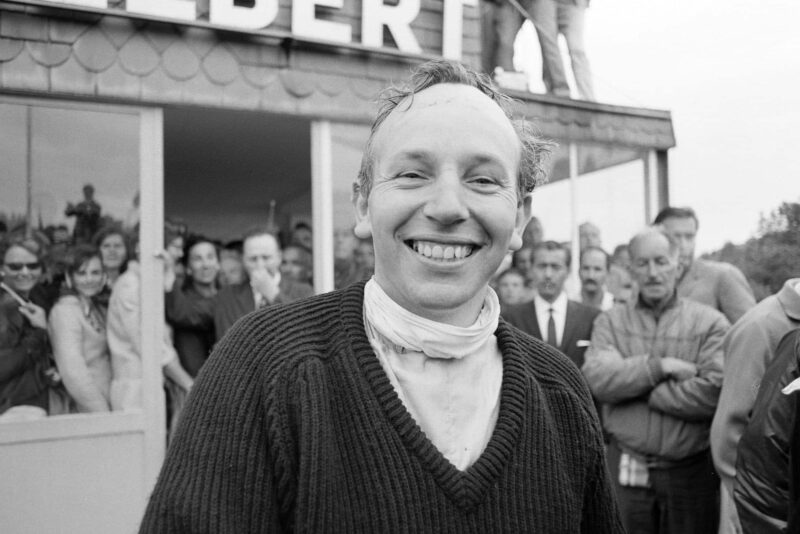
Surtees is suitably delighted after winning
Motorsport Images
Spa Splutters
- The new H16 BRM engine is a splendid piece-of Grand Prix machinery, but not really the thing for non-works mechanics to have to look after. I suspect that a lot of people who criticise its performance to date have had no experience of assembling a single-cylinder racing engine, let alone a 16-cylinder.
- I would have thought a lap at an average speed of 232.844 kph (nearly 145mph) would have convinced most people that a 3-litre GP car is an exciting piece of machinery; and that Surtees ranks pretty high as a GP driver, but a depressing number of people seemed singularly unimpressed; or is it going to be “fashionable” to be lukewarm in your enthusiasm for anything other than Mini racing.
- How nice it was to see Dan Gurney’s AAR Eagle arrive with a well designed bodywork that covered everything, even the gearbox.
- The McLaren team had done some extra high-pressure work to modify the chassis, couple the Serenissima V8 engine to the ZF gearbox and install the whole lot in barely a week, for if included the redesign and manufacture of oil lines, fuel system and exhaust systems as well as engine mountings. What a great pity that it was all to no avail.
- Italian engines finished first, second and third, which should point a moral, or something, and drivers were British, Austrian and Italian, with a British chassis between two Italian ones. A result of true International character.
